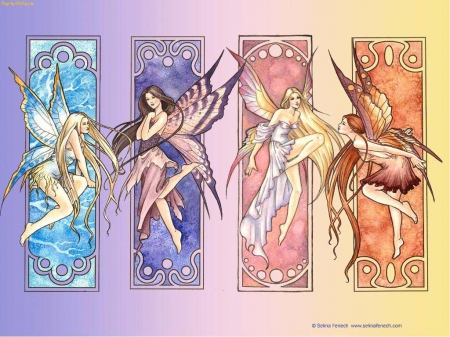Lancashire. 1921. We are surrounded by a dancing group of lovely female fairies. They are laughing and full of joy. The leader in this case is a female figure, probably two feet high, surrounded by transparent flowing drapery. There is a star on her forehead, and she has large wings which glisten with pale, delicate shades from pink to lavender; in rapid movement, however, the effect of them is white. Her fair is light golden brown and, unlike that of the lesser fairies, streams behind her and merges with the flowing force of her aura. The form is perfectly modelled and rounded, like that of a young girl, the right hand holds a wand. Although her expression is one of purity and ingeniousness, her face is at the same time stamped with a decided impression of power. This is especially noticeable in the clear blue eyes, which glow like a flame and have all the appearance of a living fire. Her brow is broad and noble, her features small and rounded, the tiny ears are a poem of physical perfection. There are no angles in this transcendently beautiful form. The bearing of head, neck and shoulders is queenly, and the whole pose is a model of a grace and beauty. A place blue radiance surrounds this glorious creature, adding to her beauty, while golden flashes of light shoot and play round her head. The lower portion of the aura is shell pink, irradiated with white light. She is aware of our presence and graciously remained more or less motionless for the purpose of this description. She holds up her wand, which is about the length of her fore-arm and is white and shining glows at the end with a yellow light. She bows low and gracefully, much as a great prima donna might bow on taking leave of a highly appreciative audience. I hear a very faint, far away music, too find-drawn to translate, such music as might be given forth by diminutive needles, delicately tuned, hung and struck with tiny hammers. It is more a series of tinkles than a consecutive air, probably because I am unable to contact it fully. Now the whole group has risen into the air and vanished. Geoffrey Hodson, Fairies at Work and at Play, (London: Theosophical Publishing House, 1930), 82-83


